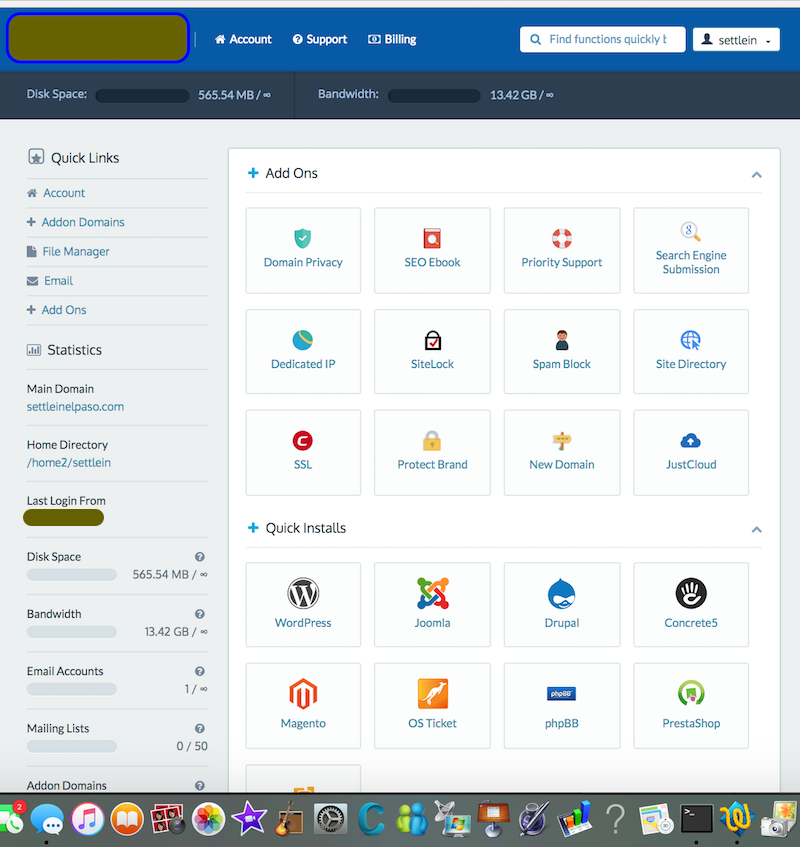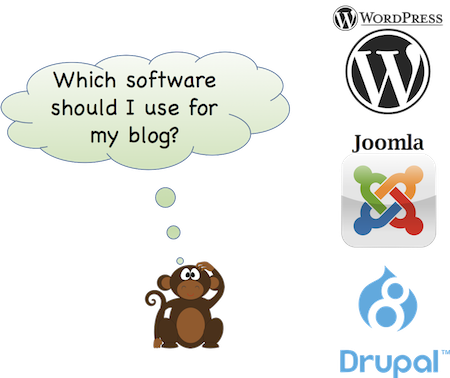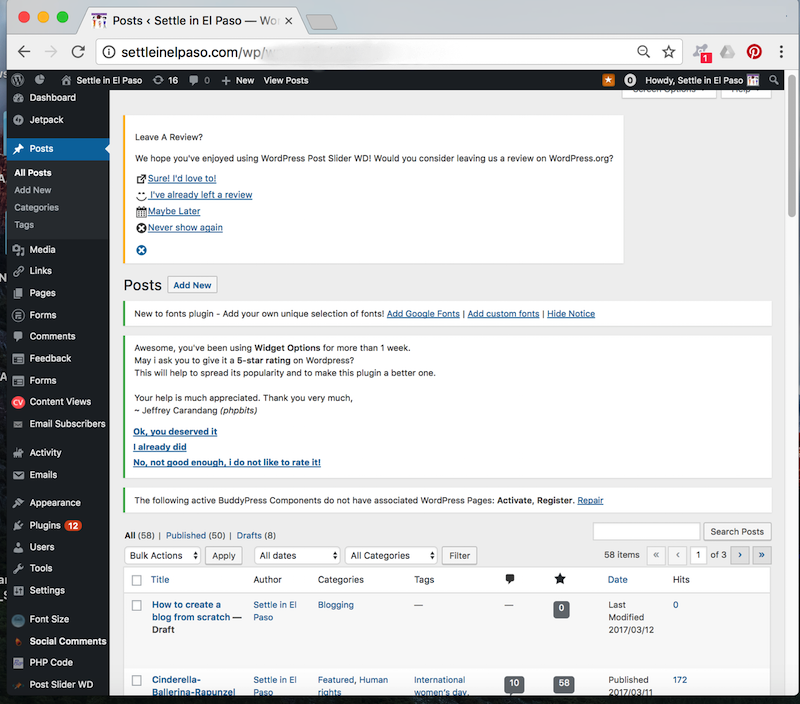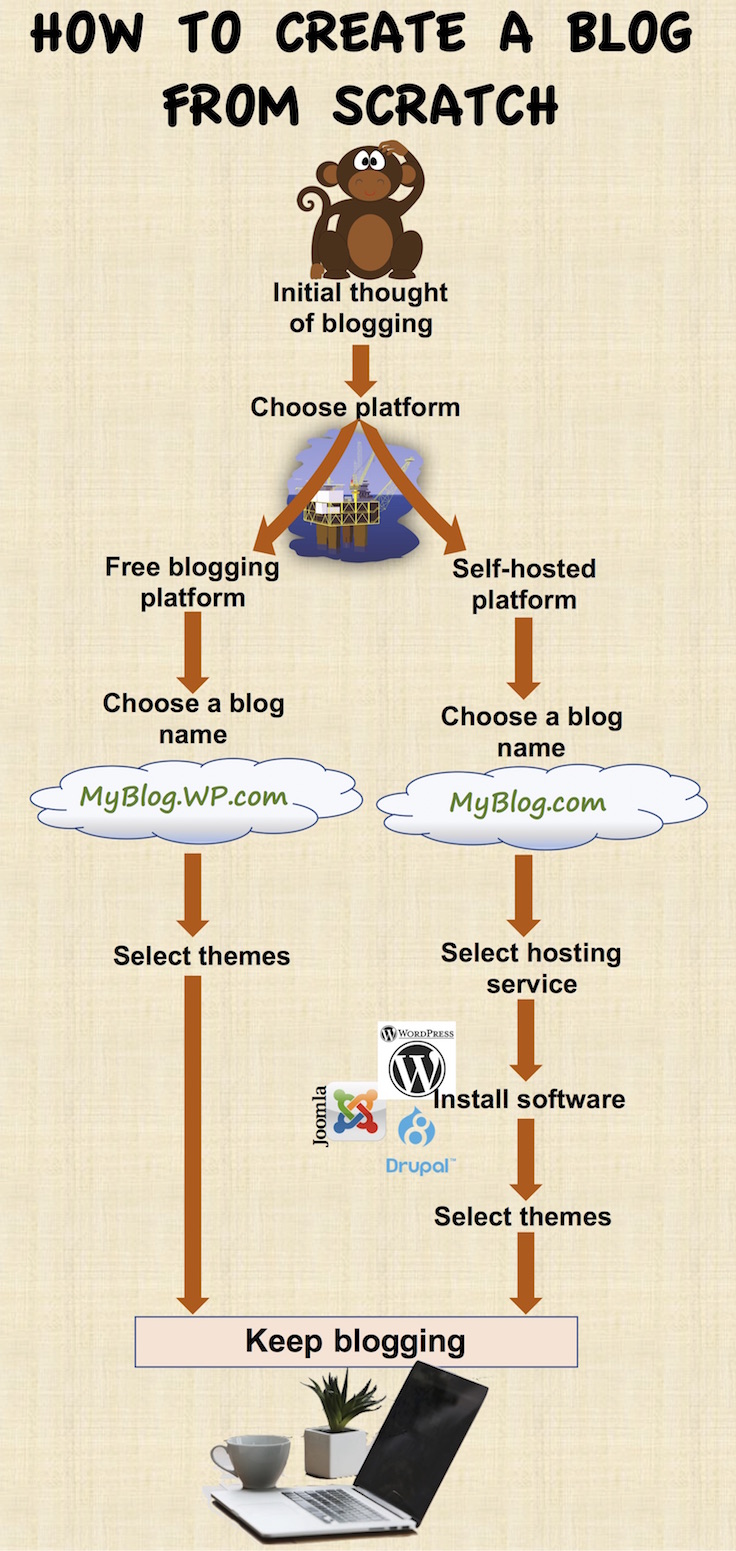
Well, nothing in this world starts from scratch. 🙂 You know what I mean; everything has some parts already done. I want to create a blog; what would I do? I asked Dear Wife a few years ago — how to create a blog — when I felt that we should start writing about our family lifestyle. Dear Wife is an avid reader and follower of the blog world, which I was not at that time. She replied, “Honey, you can create a blog on any existing blogging platform. Or, you can create your site if you are serious.”
It turned out that it was not a whim; I was damn serious. 🙂 In this post, I will attempt to highlight the basic steps required to create a blog from scratch (to the point the blogging effort remains reasonable). I will not describe too much of how to do every step, but I will provide enough information that will help create a blog from scratch. 🙂 Sorry, I use too many smileys in my posts. In reality, I do not smile that often.
Choosing a blogging platform
Dear Wife said, there are two ways: using an existing platform or using your site. I interpreted Dear Wife’s statement about seriousness incorrectly at that time. I thought serious bloggers did not use existing platforms. What she meant was that if I am serious, I can go ahead with web space for my website. If I am not serious, then an existing (free) blogging platform can be used for testing purposes. I observed in my short blogger life that many bloggers on the wordpress.com platform have thousands of followers and influential content. Therefore, the statement that only bloggers with self-hosted sites are serious is an incorrect one. Anyway, my thought process is taking me to a different discussion. Please allow me to force the flow with the topic. Where was I? Oh yes, existing platform and self-hosted platform.
Existing platform vs. self-hosted platform for blogging
ⓘWhat is an existing blogging platform?
An existing blogging platform is commonly known as a free blogging platform. Widely used free blogging platforms are WordPress.com, Blogger.com, Medium.com, ghost.org, and many other similar sites. Opening a free account on WordPress.com would result in a blog link with the address https://YourBlogName.wordpress.com, where YourBlogName is the name you have chosen.
ⓘ What is a self-hosted blog?
A self-hosted blogging platform is a website that you own. You will purchase a domain name and server space to host your website. Any website name is possible, provided that someone else did not already take the name. There are many hosting companies, including HostGator, SiteGround, iPage, Bluehost, and GoDaddy.
An advantage of using a self-hosted blog is that you will have full control over your blog. You can choose plain HTML, or you can install a blogging platform like WordPress (commonly known as WordPress.org) on your website. In a self-hosted blog, you have full access to any file on your website. You can install any theme you want. The price of hosting a site can be as little as $1 a month. For a good amount of web space, one only needs to spend five or six dollars per month.
If you choose a free blogging platform, then you are ready to roll. Select a name, choose a theme, make a few cosmetic changes, and start blogging. If you prefer a self-hosted site, the rest of the article should provide you with more information. Even if you do not prefer a self-hosted site, you can still read the rest for the information that you might need in the future when you decide to create your blog.
Choosing a name and URL
A rose by any other name would smell as sweet. The proverb is c, but I will still try to keep the blog name and the URL relevant to the blog niche. For example, a blog that discusses plants should not have a name The Art of Selling Books. A plant-related blog should not have the URL http://WeSellBooks.com/ either. Anyway, once you have a good name for your blog, you will need to do a little bit of research to check if someone else already owns the name. We always prefer a unique name so that it is discoverable by search engines without any confusion.
Each hosting site has a domain name availability checker. Some will also show alternative names. GoDaddy has a domain name availability search tool in this link. The domain name forms the Uniform Resource Locator, commonly known as URL.
Selecting a web hosting service
As said before, there are many hosting companies, including HostGator, SiteGround, BlueHost, iPage, and GoDaddy. Some important parameters one should consider when selecting a web hosting service are discussed below. All the parameters boil down to the question: Is this host good for my blog?
ⓘ Traffic
If I am planning on a personal blog that will have low to medium traffic, I won’t worry much about whether a shared or dedicated server is used. Most personal blogs are fine with a shared service. By shared service, I mean that the same server computer serves many websites, but the world will have the illusion that each website is running independently. E-commerce websites and blogs that have grown too big over time might not be suitable for a shared web hosting service. Shared web hosting is appropriate for a low or medium-traffic blog. Shared web hosting services are cheaper than dedicated ones. The majority of the blogging world depends on shared web hosting.
ⓘ Disk space
Even with small family blogs like ours, the demand of disk space may multiply, especially because of the images and the videos we share. Many bloggers use YouTube to upload videos and other publicly available websites to host images. If you prefer to keep your images within the space of your website, it will be better to choose a hosting that allows enough disk space. Nowadays, unlimited or unmetered web space is becoming available at a low cost.
ⓘ Bandwidth
Bandwidth is related to the amount of data that can be transferred from and to the hosting server. In earlier times, the bandwidths of hosting services were limited. I do not think new hosting services include any restrictions over bandwidth. Make sure to check if bandwidth is unmetered even when you have a basic plan. I prefer another company if one hosting service does not provide unmetered bandwidth with a basic web hosting plan these days.
ⓘ Email accounts
Does the web hosting platform provide an email system for my blog? If I have a website named https://settleinelpaso.com/, I would prefer an email address like MyEmailID@settleinelpaso.com, especially for blog-related communications. How many people will manage this blog? Based on that number, I will need that many email accounts. Nowadays, a basic plan includes email address capabilities. I would make sure that the service allows the creation of enough email accounts.
ⓘ Subdomains
Suppose we have a website with the URL https://settleinelpaso.com. Does our hosting service allow subdomains? Let us exemplify the question: Can we create two websites, https://DearMom.settleinelpaso.com and https://DearDad.settleinelpaso.com? Subdomains help brand URLs for products, create user-based websites, or categorize posts through different URLs under the same website.
ⓘ Domain Parking
Domain parking refers to the registration of a domain that is not in use yet, but you are reserving it for the future. While this is not quite important for personal blogs, business owners might prefer to park a few domains that are close to the brand name they are using for their products. For example, if I have a blog URL www.myBlog.com, I might prefer to reserve www.myBlog.org, www.myBlog.biz, and www.myBlog.blog. It is not very important for personal blogs like ours, but it might be important for large brands.
ⓘ Availability of Blogging Tools
I would prefer a host that provides easy access to popular blogging software. The next section provides further details. My personal preference is WordPress. Some hosts advertise that WordPress installation is just one click away. This means the hosting service has an easy way to install WordPress on your self-hosted site.
Based on all these items and some user reviews, you will decide which hosting service is the best. Move forward with that. You can purchase the domain subscriptions and the hosting space for three years, reducing the per-month cost.
Software installations on the server
Based on what type of blog you are building, there can be different software requirements. The most common technical requirements are Linux, Apache, MySQL, and PHP. Most service providers ensure that these items are functional. Other than the technical requirements, I would say that the following software pieces or interfaces are essential for personal blogs.
ⓘ Management interface
This is the interface of the hosting service. That is, you will log in to this web interface on the hosting company’s website. For example, if you purchase a hosting service from BlueHost, you will log in to the management interface on https://www.bluehost.com/ whenever required. The questions to ask here are: is the interface easy enough for the installation of the software pieces? Or does the interface provide a standard File Manager? In a sense, this management interface is the web hosting control panel for your website. The most widely used panel is cPanel. Some alternatives are Sentora, Froxlor, ServerPilot, ISPConfig, and Virtualmin/Webmin. I requested cPanel when I purchased my service.

cPanel-like management interfaces are generally not accessed as frequently as the blogging software. Once someone installs WordPress on the self-hosted site using cPanel, web development tasks are done from the WordPress interface of the blog. Therefore, the use of cPanel is minimal. cPanel is used for major changes in the service, domain name-related tasks, email setup, FTP management, database management, file management, backup management, and such system-level activities.
ⓘ Email Clients
I expect that the hosting service will provide several email addresses under the domain name I have purchased. A web-based system on the server side is necessary to maintain these email accounts. This email interface is commonly known as a Webmail application. SquirrelMail, RoundCube, and Horde are some examples of Webmail applications. The self-hosted site will need at least one email software.
I prefer to use a public email like Gmail. I set Automatic Forwarding from the email application associated with my blog to the Gmail account. That way, I do not have to access an additional email for my blog. The email management application on my self-hosted site helps me set these Automatic Forwards.
ⓘ Blogging software
A blogging software is something that makes the life of a blogger easier. 🙂 We do not want to worry about all the expertise required to learn HTML, PHP, SQL Queries, and so forth. A blogging software hides all those complexities. Bloggers who would like to write codes have the flexibility to write complex codes through blogging software.

Some examples of blogging software are WordPress, Joomla, and Drupal. As said earlier, my personal preference is the WordPress installation. I would make sure that there is an easy WordPress installation for a hosting service I will purchase. WordPress, Joomla, and Drupal are all free to use, so there is no need to pay extra for the blogging software.

WordPress blogging software on a self-hosted site comes from WordPress.org, which is different from Worpress.com. Note that Worpress.com is an existing blogging platform. If I already have a WordPress.com account, I can connect my self-hosted site with the WordPress.com account via a plugin called Jetpack. You can install the Jetpack plugin after installing WordPress on the self-hosted site. Jetpack allows a seamless connection with the WordPress.com community. It allows WordPress.com users to provide Comments and Likes on my self-hosted site. I find Jetpack a strong way to be a part of the blogging community.
Keep blogging
While creating a blog from scratch may sound intimidating at first, the real hard step is to keep blogging consistently.
Additionally, consistent blogging is the part that you will enjoy the most. Keep posting consistently. Bloggers need to keep creating great content. Keep networking with the beautiful minds of the free world!
Note: We posted the article first on March 13, 2017, revised it, and reposted it later.
Subscribe to receive our newsletters and notifications on new posts.




I have been writing online for many years, but my blogs are only two years old. Even though I knew having my own blog was more beneficial than publishing on other sites, I did not launch my own blog because I was not sure whether I can actually earn from my blogs. Currently, I have half a dozen wordpress websites on various niches. You have a wonderful infographic up there. I have read som many DYI articles about creating a blog, but this is the most informative article I have read. Thank you very much.
Personally, I prefer the self hosted option. I have used both WordPress.com and the self hosted WordPress and I have to say if you know what you are doing then it is always better to go down the self hosted route. You can just do so much more with it. It will be slightly more expensive because you have to worry about domains and hostings but it is worth it in the long run. WordPress is also good because you can include so much more, if you wanted you could make your blog have a much more social experience.
I promised myself that I’m getting into action after reading such an article about how to create blogs. I mean reading articles on your blog over time has made me have an understanding of lots of things and this latest proves that you’re really good at what you enjoy doing which is to write. Thank you for this awesome information on how to start up a blog.
I am so happy to see such beautiful words. I am glad that you found the posts informative. Thank you so much for visiting and commenting.
That’s one of my goals, to publish a blog. I don’t know how or where do I start. I don’t have an Idea on what to post or how to create one until now. Thanks for your post. It really helps a lot. Good work. 🙂
Glad to know that the post was helpful. Have a wonderful evening.
Thank you for your guide sir! I am really planning to be a blogger and this is very helpful. I will save this for me to scan it and review it over and over again. Thanks!
This was quite explanatory and educative.Book-marked this page already.you really described all aspect of blogging. Good to understand all the terms associated with blogging.Thanks for this.
This article is very informative and I really like that and taught me a few new tricks that I didn’t know already. I’ve already had some experience creating some blogs. The sites I used were through WordPress.org and I hosted my side through HostGator.com and the says work for me ever since. As the last part of your article states to keep up with your post, that’s where I fell off because I got distracted with life events.
Oh, definitely the distraction part — no escaping from that, especially for grownups with kids. 🙂 Thank you for visiting and commenting. Have a wonderful Sunday.
Wow, this is amazing how you cover all the subject and we cannot add anything to it. All your advice and tips are a good tutoring help in making a blog. It is hard enough to follow all the steps but I think is much harder to get traffic and start earning from our blog!
Absolutely, getting started is comparatively the easy part. As you said, consistently publishing and aiming an objective is the hardest part. Thank you so much for you visit and all your excellent comments.
Wow! This is very in-depth! This is good info especially those who are still beginning their journey into the blogging world. I myself have started with some free hosting sites like webs.com and weebly. But I noticed that it’s hard to monetize websites that are free hosted. Also, they look very unprofessional.
I finally decided to avail of a paid hosting service, and up to this day, I still am using their service. The challenge here is to be able to afford the monthly cost of web hosting plus generating a bit of profit on the side. I hope that you’ll give us a tutorial on what ways you use to monetize your sites. Cheers!
Thank you for the kind words.
My wife and I are both working full time on other jobs, which makes it difficult to actively monetize the blog. Our plan is to create a reader-base first and then grow the blog very slowly over a few years. We have implemented Adsense (and recently Amazon Affiliate Program) though. We will write on them when we have enough insight.
Thank you for visiting and commenting.
That is true. It’s kind of hard to write quality articles on a consistent basis while having to worry about your day job. I also am having trouble creating content for my sites because my current job requires me to be there from 8 am in the morning to 5pm in the afternoon. When I come home from work, in usually drained and exhausted. 🙁
It’s nice that you have already incorporated adsense as its one of the best ways to monetise a website. I’m sure that your reader base will balloon since all the content here in your blog are top quality.
Yes, it is hard with a day job. We enjoy blogging anyways. 🙂 That is the gain, I guess. Thank you for visiting and commenting.
Wow, now this is an extremely detailed, well-thought out and informative post and you have no idea how much I appreciate it. I currently already have a blog set up but it’s very small and it’s just in the beginning stages. After reading your post I have realized and found many aspects of my blog that I can improve on and optimize! I am not very handy with different software so guides like yours are absolutely amazing. Again, thank you! You should make more 🙂
I am so happy to know that you found this post informative. Thank you for letting us know. Have a wonderful week ahead.
This is the best blog creation guide I have ever seen. I have tried many blog creation methods but when I tried putting them in practice I always get hooked some where. But this is simply laid out and with the visual representation it is easy to put into practice. I must say I commend this.
We are so glad to know that you liked this post and found it informative. Thank you so much for your kind words. Have a wonderful day.
This is insightful and the use of images and pictorial compositions will go a long way helping the readers know the step by step stages to carry it out this is so far the most detailed ‘How to’ post I have read about creating a blog.
Thank you so much for your kinds words. I appreciate your visit and comment. Have a wonderful evening.
Who says nothing can be started from scratch. I am going to bookmark this blog and read though minutely as that is what will be required if I am to create a state of the art blog I do have one but I could call it systematic wilderness. You have rightly said updating is the most difficult part Mine is languishing there but not for long I can promise myself that.
Glad to know that you found this post useful. Thank you for visiting and writing the kind words. Have a wonderful day.
I have had a lot of free blogs and some of them seemed to take of for a while and others just failed from the start I now see that in many ways I have time after time missed some vital steps and are going to apply these steps to my next blog. Thank you for sharing your decision making process!
I am happy to know that you liked this post. Thanks for visiting and commenting.
You gave me interesting information About blogging.
Kind regards,
I am glad that you liked this post. Thanks for visiting and commenting! Have a wonderful weekend.
Nice BLOG!!! ADD my BLOG too!!! Kisses!!!
Glad to know that you liked our blog. Looking forward to visiting your blog as well. Have a wonderful week.
Thanks!!!
Wow – a treasure trove of information. Thanks!
Glad to know that you find this informative. Thanks for visiting and commenting. Have a wonderful week.
This was very, very helpful. I had no idea there were so many things involved in blogging. I just signed up on WP and started writing :-/
We are glad to know that you liked this post. There are some steps involved with the self-hosted sites but they are not as hard as they look at the first glance. ? Thanks a ton for visiting and commenting. Have a wonderful weekend ahead.
Very thorough explanation. I’m sure this will help a lot of people who are wondering how to get started.
Juliann recently posted…File This Fact Away
Thank you for your kind words. I too hope that this will be helpful to start. Have a great day.
Great information!
Glad to know that you liked it. Thank you.
I am betting many folks will appreciate your helpful hints.
I am very glad to hear the nice words. I am excited to know that you liked the post. Have a wonderful week.